| Designation: | FH-77A |
 |
|---|---|---|
| Manufacturer: | Bofors Defence AB | |
| Product type: | Weapons & Weapon Systems | |
| Name: | Towed gun |
Studies between 1965 and 1968 to establish the future requirements of Swedish Army artillery weapons led to the recommendation that a 155 mm howitzer with an Auxiliary Propulsion Unit (APU) should be developed. It was required to have a long range, high rate of fire, use an improved type of 155 mm ammunition and have good mobility, especially across rough terrain and snow.
AB Bofors (which is now BAE Systems Bofors) was subsequently awarded a development contract by the Army Materiel Department of the Defence Materiel Administration to develop a new weapon, which became the FH-77A.
The first prototype was built in 1973 with the main production run being carried out from 1978 to 1984 for the Swedish Army. Further development resulted in the FH-77B covered in a separate entry. In 2007 this was the only field artillery system in front-line service in Sweden.
It is estimated that total production of the FH-77A amounted to 200 guns before production switched to the FH-77B. Of the 200 FH-77A systems supplied to the Swedish Army, 100 are held in reserve with the remaining 100 being for sale via the UK based Leavesley Group.
The first customer for the FH-77B was India who ordered 410 systems. It has also been adopted by Nigeria (48) and Sweden (51).
There has been no recent production of the now BAE Systems Bofors 155 mm FH-77A or FH-77B.
The now BAE Systems Bofors FH-77A is normally towed by a Saab-Scania SBAT 111S (6 × 6) truck at a maximum road speed of 70 km/h. When travelling across rough terrain the main wheels of the howitzer can be engaged making an 8 × 8 combination. Maximum speed in this configuration is 8 km/h and once this speed has been exceeded the wheels of the FH-77A are disengaged.
Mounted on the forward part of the carriage is a Volvo B20 engine which is connected to two variable hydraulic pumps. These are connected to hydraulic motors in the driving wheels and, when being used in the self-propelled mode, steering is by means of levers at the driver's position on the left side of the carriage. Both driving and steering are accomplished by the large roadwheels. The two support wheels, one on each trail, pivot freely and are also hydraulically operated and assist in limbering and unlimbering the weapon.
The elevating mass, which is supported in the cradle carrier, consists of a cradle that carries the barrel with the breech mechanism, recoil mechanism and loading tray and rammer for the loading system. The semi-automatic breech mechanism has a vertical sliding breech block which opens downwards. The firing device is electromechanical. Elevation and traverse are both hydraulic at a maximum speed of 3°/s.
On the right side of the FH-77A is the loading table on which the 155 mm projectiles are placed with the aid of an ammunition crane. The cartridge cases are placed manually on the loading tray. The loading device is operated by the loader who is seated on the right side of the howitzer.
Swedish Army weapons had the BEAB BAAB RIA sight which is operated by the driver/layer on the left side of the carriage.
The crew of six of the FH-77A consists of the commander, gunner who lays the gun and also acts as the driver, ammunition handler who places the cartridge case onto the loading table, loader who feeds the projectile from the loading table and operates the rammer, crane handler who lifts three projectiles at a time onto the loading table and the ammunition handler who screws the fuzes into the 155 mm projectile.
On arriving at the battery position the howitzer can be unlimbered by raising the castor wheels on the carriage trails with the aid of the hydraulics. The lunette is thereby raised and unhooked from the pintle. Once the howitzer has been unhooked the carriage trails are spread by releasing the locking device between the carriage trails. The howitzer is then swung first to one side and then the other, the carriage trails locking in their outer positions. The supporting wheels are turned up, and the howitzer, oriented in the firing direction ordered, is driven in reverse to dig in the trail spades. If the howitzer needs to be re-oriented to a new firing direction beyond its traverse limits it is driven forwards to free the trail spades and the supporting wheels are turned down. Once in the new firing position the supporting wheels are turned up again and the howitzer is again reversed to dig in the trail spades.
The FH-77A is also provided with hand pumps, one for laying and ramming and one for the castor wheels, which can be used to obtain the pressure required in the hydraulic systems if the auxiliary engine should be out of order. These hand pumps can also be used for quiet operation of the 155 mm FH-77A howitzer at night.
The unit loads of ammunition (both projectiles and charges) facilitate handling and can be stacked on each other. Each contains 12 projectiles or 12 cartridge cases and is kept unopened all the way to the ammunition supply at the gun. With the aid of the ammunition crane, three shells at a time can be taken directly from the unit load and transferred to the loading table of the gun. The cartridge cases are kept in special plastic tubes, with covers on one end. The tubes, which are inserted horizontally into the unit loads, can be opened and the cartridge case removed without having to break the unit load. If the situation should require manual moving of the cartridge cases, the unit load is divided into separate tubes in which the cartridge cases are carried.
The firing sequence is as follows. A cartridge case is placed on the loading tray and then the loader feeds a projectile from the loading table and actuates the ramming device when the projectile has slipped down into the cartridge case on the loading tray. The layer then fires the weapon. The cartridge case is ejected on recoil, after which the loading cycle is repeated.
The HE projectile is designated the M/77, weighs 42.4 kg complete with the now BAE Systems Bofors ZELAR fuze and contains 8 kg of TNT. The empty plastic cartridge case has a steel base and weighs 5.9 kg; cartridge case plus increments one to four weigh 11.9 kg complete and cartridge case plus increments five to six weigh 16.7 kg. The maximum muzzle velocity with the various charges is as follows: charge 1, 310 m/s; charge 2, 371 m/s, charge 3, 472 m/s, charge 4, 583 m/s, charge 5, 692 m/s and charge 6, 774 m/s.
The 120 mm KARIN mobile coastal defence gun was developed by the now BAE Systems Bofors to meet the requirements of the Swedish coastal artillery but has now been phased out of service.
Details of the now BAE Systems Bofors 155 mm FH-77 series artillery system fitted to a 6 × 6 chassis for trials purposes and details are given in a separate entry. This is designated the Bofors FH-77 B05 L52 and also referred to as the Archer.
|
||||||||||||||||||||||||||||
|
|||||||||||||||||||||
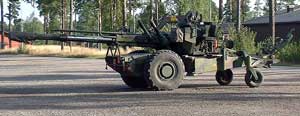 |
 |
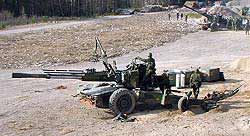 |
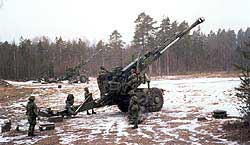 |
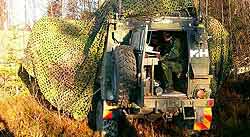 |
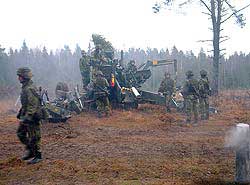 |




